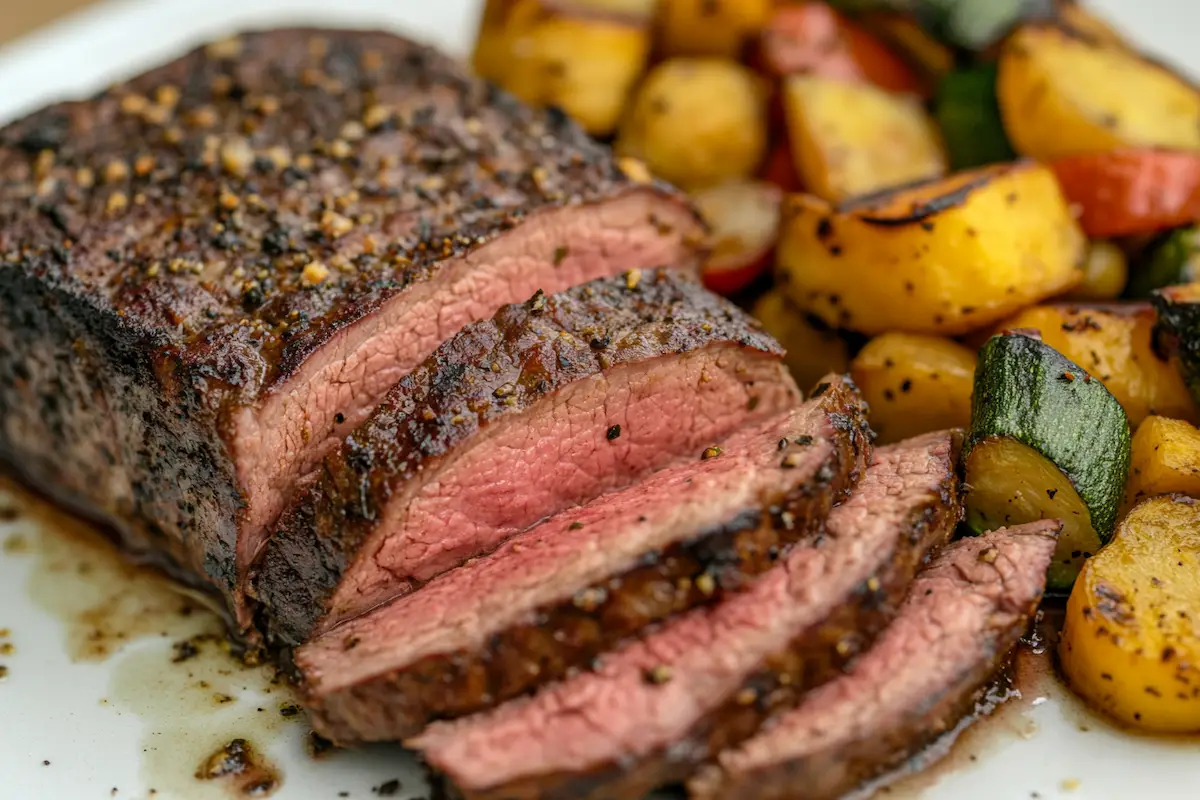This article provides a comprehensive guide to preparing a delicious beef rib eye roast, from start to finish. Learn how to cook a perfect roast, understand ideal temperatures, and have all your questions answered.
Perfecting Your Beef Rib Eye Roast
A beef rib eye roast is often the star of a memorable meal; however, preparing a roast rib eye well can seem challenging. Let’s simplify the process. This guide will help you create a juicy, flavorful roast. Therefore, you will impress your family and guests with a perfectly cooked beef rib eye roast.
Selecting Quality Beef for Your Roast
First, choosing the right cut of meat is essential. Specifically, a beef rib eye roast should have good marbling. Marbling refers to the white flecks of fat within the muscle. Accordingly, this fat makes the roast tender and flavorful as it melts during cooking. For example, for the best result, look for a roast with even marbling and a deep red color. Consider the marbling when selecting your beef rib roast.
Understanding Ribeye Meat Cuts & Options
Moreover, the rib eye is a prized cut. It comes from the rib section of the cow. You might see a “bone-in” or “boneless” rib eye. Both options work well. Additionally, the bone-in option can add extra flavor. However, boneless is easier to carve. The decision is ultimately based on personal preference. Indeed, both options can lead to a great prime rib roast.
Preparing Your Ribeye for Roasting
Before cooking, properly prepare your beef rib eye roast. Remove it from the refrigerator an hour before you plan to cook it. This helps it cook more evenly. In addition, pat the roast dry with paper towels. This is important for achieving a good sear. Therefore, make sure to do this step when preparing a roast rib eye.
The Importance of Seasoning & Flavoring
Seasoning is also essential. Use salt and pepper generously. Other spices like garlic powder, onion powder, and dried herbs may be added. However, simple seasoning often works best for a quality piece of meat. The roast has its own great flavor. Thus, it doesn’t need much to enhance it; it’s great just like it is. Remember that proper seasoning will enhance your beef rib roast.
Roasting Your Delicious Ribeye: A Step-by-Step Guide
Now let’s get to the actual cooking. A beef rib eye roast can be successful using various cooking methods. However, roasting is a favorite for many. Roasting produces a wonderfully tender inside with a delicious crust. Therefore, it’s a preferred method.
Step-by-Step Roasting Instructions: Initial Searing
First, preheat your oven to 450°F (232°C). Then, place the roast on a rack in a roasting pan. This allows air to circulate around the meat for even cooking. Afterward, sear the roast in the oven at high heat for 15 minutes. This develops a beautiful crust. Basically, the high heat is critical for searing. This technique will ensure a beautiful roast rib eye.
Adjusting Oven Temperatures for Tender Meat
After the initial sear, lower the oven temperature to 325°F (163°C). Then, continue to cook. However, the cooking time varies depending on its size. A meat thermometer is crucial. Use it to check the internal temperature of the roast. Indeed, using a thermometer is the best way to tell when it’s ready. Proper temperature control is vital for a perfect beef rib roast.
Internal Temperature Guide for Perfectly Cooked Ribeye
Generally, for rare, aim for 125°F (52°C). For medium-rare, aim for 130°F (54°C). Medium should reach 135°F (57°C). Medium-well is 140°F (60°C). Well-done is 145°F (63°C) or higher. However, remember the roast will continue to cook a little while it rests. Consequently, remove it from the oven when it’s a few degrees below your desired temperature. Therefore, aim for a slightly lower temperature than you want. These temperatures are important for a perfectly cooked prime rib roast.
Resting Time: A Key for Juicy Results
Resting the roast is vital. Tent it loosely with foil for at least 15 to 20 minutes after cooking. This allows juices to redistribute throughout the meat. It keeps the roast moist and delicious. Specifically, skipping this step can result in a dry roast. Therefore, be patient. Accordingly, resting is a key part of the process. Proper resting makes a big difference for your roast rib eye.
Elevating the Flavors of Your Roast Ribeye
You can also boost your roast. Several additions can complement the rich flavor of the meat. Consider adding herbs or aromatics during cooking. These options can elevate your meal. Thus, you can add extra flavor.
Adding Aromatics and Fresh Herbs for Depth
Fresh herbs like rosemary and thyme are great choices. Place them in the roasting pan around the meat. You can also add garlic cloves. These aromatics infuse the roast with subtle flavor. However, do not put them directly on top of the meat, or they might burn. Therefore, distribute them around the meat. Enhancing your roast with aromatics will improve the flavor profile.
Using Garlic to Infuse Flavor into your Ribeye Roast
Garlic is particularly wonderful. Add whole cloves or mash them into a paste. You can also rub the roast with a garlic paste. For best results, do this before seasoning. Indeed, garlic will infuse the meat with great taste. Garlic is essential for a flavorful beef rib roast.
Additional Flavor Enhancement Techniques
Experiment with other flavors too. Consider adding some red wine to the roasting pan. This adds depth to the gravy. Additionally, a bit of beef broth or stock helps to prevent the roast from drying out. Thus, you can keep it moist and flavorful.
Creating a Delicious Pan Gravy From Drippings
The pan drippings make a flavorful gravy. After the roast is rested, pour the drippings into a saucepan. You can add flour for thickening. Simmer the mixture on the stovetop. Skim off any excess fat, and season to taste. It’s a classic addition to any roast. Furthermore, it uses the flavorful drippings. A good pan gravy is the perfect complement to a roast rib eye.
Carving and Serving Your Roast Rib Eye
Now, it’s time to carve your roast and serve it. Use a sharp carving knife. Cut against the grain for the most tender slices. Serve immediately for the best eating experience. Generally, serving right after carving is best. Serving your beef rib roast properly will enhance the experience.
Choosing the Right Carving Knife for Success
A sharp carving knife is essential. A dull knife will tear the meat. It may also cause the juices to run out. A sharp knife allows for clean, even slices. In addition, it helps keep all the flavor and moisture within each piece. Therefore, choose a sharp knife. The right knife is crucial for carving your prime rib roast.
Techniques for Carving Tender Ribeye Slices
Carve the roast in even slices. The thickness of the slice depends on your preference. Usually, slices are about half an inch thick. However, you can make them thicker or thinner. Serve immediately to enjoy the full flavors. Specifically, carve and serve immediately. Proper carving techniques will ensure a tender roast.
Side Dish Suggestions to Complement the Ribeye
Consider your sides. Creamy mashed potatoes and roasted vegetables are great options. They perfectly balance the richness of the meat. Green beans, asparagus, and carrots are great choices too. Additionally, Yorkshire pudding is a classic side. Moreover, choose sides that you enjoy. Consider your favorite side dishes to complement your beef rib roast.
Wine Pairing Recommendations for your Rib Roast
For a full meal, try pairing your roast with a robust red wine. Cabernet Sauvignon or Merlot is generally excellent with beef. The flavors complement each other beautifully. Conversely, consider also a dry red wine like Malbec. It is equally great. Ultimately, choose your favorite red wine that pairs best for you. Thus, you can have a truly special meal. A good wine pairing elevates your prime rib roast.
Storing and Reheating Leftover Ribeye
Occasionally, there may be leftover roast. Store it in an airtight container in the refrigerator. Use it within three to four days. You can also freeze the cooked beef. It will last for up to three months. Therefore, you can use leftovers later. This will allow you to enjoy your beef rib roast for longer.
Safe Storage Practices for Leftover Roast
Store leftover roast in a shallow container. This allows it to cool quickly. It also ensures the meat cools evenly. Always keep cooked beef in the refrigerator to prevent bacterial growth. Indeed, refrigeration is key for food safety. Proper storage will help maintain the quality of your roast rib eye.
Tips for Reheating Ribeye Without Drying it Out
To reheat, gently warm the beef in a pan or oven. Add a little broth or water to keep it moist. You can also microwave the beef. However, be careful not to overcook it. Reheating can dry out the beef if it is not done properly. Furthermore, low and slow reheating always has the best results. Accordingly, reheat carefully to preserve flavor. Proper reheating is important to maintain the taste of your prime rib roast.
Frequently Asked Questions About Cooking Ribeye Roast
Here are some common questions. This section will help you understand everything better. You will find all the info you need for success. Specifically, this section answers your questions.
Is a Ribeye Roast the same as Prime Rib? Understanding the Differences
Yes and no. The terms are often used interchangeably. Both come from the rib area. However, prime rib often refers to a roast with the rib bones still attached. A beef rib eye roast can be bone-in or boneless. Specifically, the term refers more to the specific cut of beef. Thus, it’s about the cut, not the bone.
Is Ribeye a Good Cut for Roasting? Advantages of Using Ribeye
Yes, absolutely! Ribeye is one of the best cuts for roasting. It has a high degree of marbling. Therefore, it’s very flavorful and tender. The fat melts during cooking. As a result, it keeps the roast juicy and moist. Furthermore, the resulting crust becomes crispy and delectable. It’s a great choice for any special occasion. Indeed, ribeye is an excellent choice for roasting.
What is the Ideal Cooking Temperature for Ribeye Roasts?
The ideal temperature depends on your preference. For rare, aim for 125°F (52°C). For medium-rare, reach 130°F (54°C). Medium is 135°F (57°C). Medium-well is 140°F (60°C). Well-done is 145°F (63°C) or higher. However, always use a meat thermometer to ensure accuracy. Therefore, a thermometer is important for best results.
Best Methods for Cooking a Ribeye Roast for Optimal Results
Rib eye is best cooked by searing first. Then, finish with low and slow roasting. The high heat creates a lovely crust. Then, slow cooking makes the inside tender. Additionally, resting the roast after cooking is vital. Consequently, this step helps keep it juicy and delicious. Ultimately, this method yields the best results. Thus, sear first, then roast slow.
For More Delicious Recipes:

